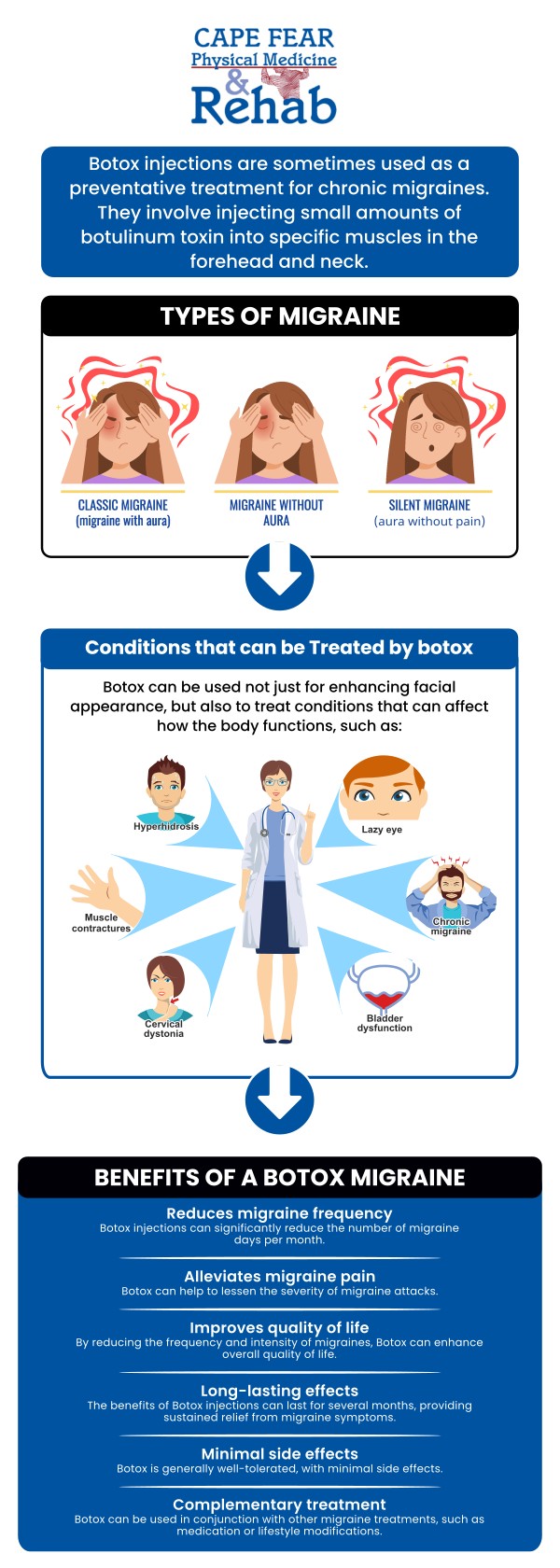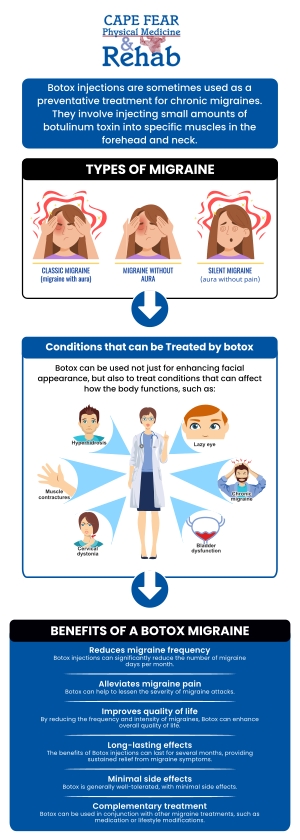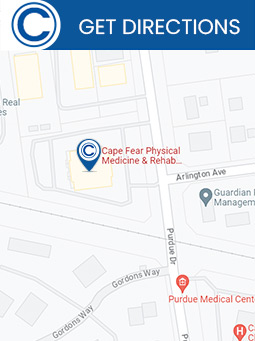Does Botox Help Treat Chronic Migraines?
Chronic migraines can severely affect your daily life. At Cape Fear Physical Medicine, we offer Botox treatments to help reduce the frequency and intensity of migraines, especially for those with 15 or more headache days per month. Our professional team provides personalized care to improve your quality of life. Contact us today for more information or schedule an appointment online. We are conveniently located at 1540 Purdue Dr, Ste. 200, in Fayetteville, NC 28303.




Table of Contents:
What kind of migraines does Botox help?
Does Botox work for migraine headaches?
How often should you get Botox for migraines?
Is Botox for migraine treatment covered by insurance?
Botox is injected into the muscles around the head and neck to reduce muscle tension. This can lead to a decrease in the frequency and intensity of headaches and migraines. In addition, patients may experience decreased sensitivity to light and sound which often accompanies migraine attacks. Treatment sessions typically last 15 minutes or less with no downtime necessary following the injection. Patients usually start to feel relief from their symptoms within 2-4 weeks after treatment begins, with maximum benefit achieved at 12 weeks post-injection. Furthermore, results can last for up to 3 months before another treatment is needed.
Migraines are classified into four categories: migraine with aura, migraine without aura, chronic migraine, and episodic migraine. Aura migraines are characterized by neurological symptoms such as visual disturbances, sensory changes, or speech problems that may precede the headache. Migraine without aura is the most common type of migraine and is characterized by one-sided throbbing pain often accompanied by nausea, vomiting, and sensitivity to light and sound. Chronic migraines are defined as having more than 15 days of headache per month for 3 months or longer. Episodic migraines are when patients experience fewer than 15 days of headache per month.
Botox is most effective in treating the most severe types of chronic migraines, especially those with 15 or more days of headache per month. It may also help treat other types of migraines such as cluster and tension-type headaches.
In clinical trials, Botox was shown to reduce the frequency and intensity of migraine attacks in chronic migraine sufferers. A study conducted by the American Society of Plastic Surgeons found that 73% of participants reported a reduction in headaches after just 3 treatments. In addition, 66% reported an overall improvement in symptoms such as nausea and light and sound sensitivity when compared to those who received placebo injections.
The frequency of Botox treatments will depend on how well the treatment is working for you. In general, patients should start to see relief from their symptoms within 2-4 weeks after beginning treatment, and maximum benefit achieved at 12 weeks post-injection. Results typically last for up to three months before another treatment is needed.
Botox can be a safe and effective way to treat chronic migraines when administered by a qualified healthcare provider. If you’re dealing with chronic migraine pain or chronic pain that’s been resistant to other treatments, consider speaking with our doctor about whether Botox may be an option for you.
Whether your insurance covers Botox for migraine treatment depends on the specific policy you have. At Cape Fear Physical Medicine, we understand the importance of making treatments and services affordable. That is why we accept most major insurance plans for our Botox treatments to help treat chronic migraines. Our skilled team can work with you to determine your coverage and ensure that you get the care you need at a price that fits within your budget. We strive to make sure that all patients have access to quality medical care without breaking their bank accounts.
If you’re suffering from chronic migraines and other treatments haven’t worked, consider speaking to our pain management doctor about whether Botox may be the right option for you. At Cape Fear Physical Medicine & Rehab, we specialize in Botox treatments designed to reduce the frequency and severity of migraines and alleviate chronic pain. Don’t let migraines control your life—contact us or schedule an appointment to find out how our treatments can help you live more comfortably and regain your quality of life. We are conveniently located at 1540 Purdue Dr, Ste. 200 Fayetteville, NC 28303. We serve patients from Fayetteville NC, Woodfield NC, Hope Mills NC, Fort Bragg NC, Eastover NC, and surrounding areas.

Additional Services You May Like
▸ Weight Loss & Wellness Program
▸ Botox for Migraine
▸ EMG Nerve Conduction Studies
▸ Epidural Steroid Injections
▸ Radiofrequency Ablation
▸ Rehabilitation Consultations
▸ Facet Injections
▸ Sacroiliac Joint Injections
▸ Joint Injections
▸ Genicular Nerve Blocks
▸ Prosthetic Evaluation/Management
▸ Adjuvant Therapy/Care
▸ Spasticity Management
▸ Stroke Treatment
▸ Multiple Sclerosis
▸ Spinal Cord Injury
▸ Traumatic Brain Injury
▸ Lifestyle Medicine
▸ Phentermine
▸ Qsymia
▸ Contrave

Additional Services You May Like
▸ Weight Loss & Wellness Program
▸ Botox for Migraine
▸ EMG Nerve Conduction Studies
▸ Epidural Steroid Injections
▸ Radiofrequency Ablation
▸ Rehabilitation Consultations
▸ Facet Injections
▸ Sacroiliac Joint Injections
▸ Joint Injections
▸ Genicular Nerve Blocks
▸ Prosthetic Evaluation/Management
▸ Adjuvant Therapy/Care
▸ Spasticity Management
▸ Stroke Treatment
▸ Multiple Sclerosis
▸ Spinal Cord Injury
▸ Traumatic Brain Injury
▸ Lifestyle Medicine
▸ Phentermine
▸ Qsymia
▸ Contrave







